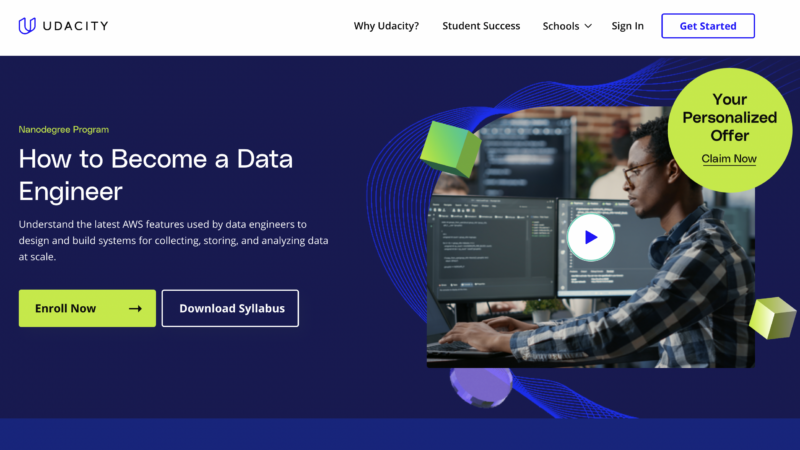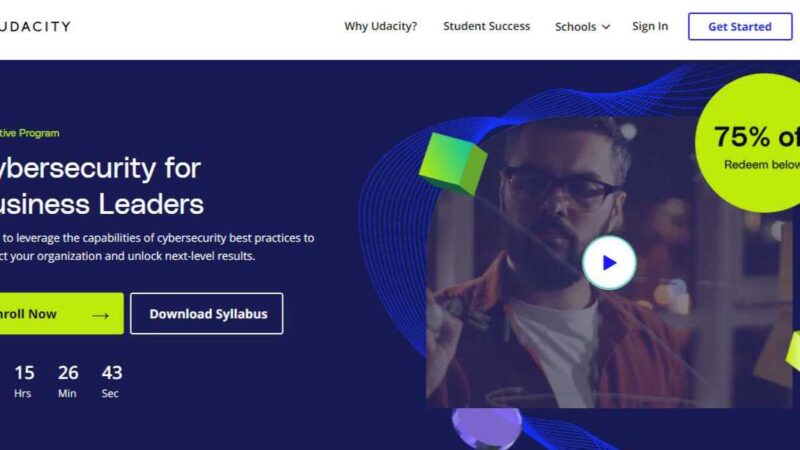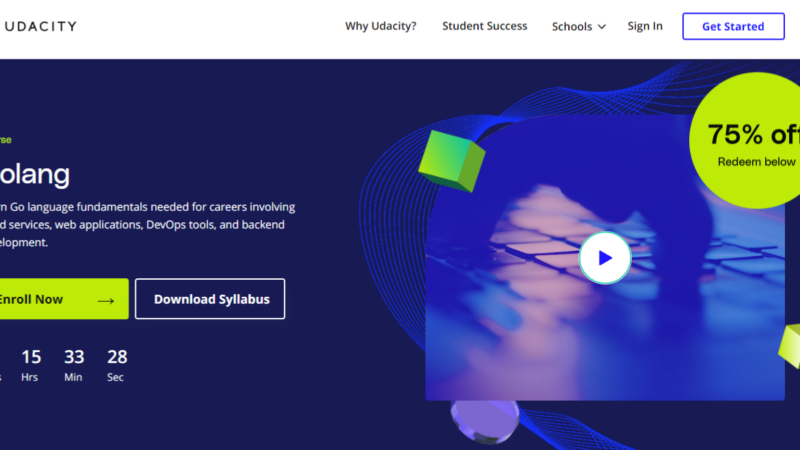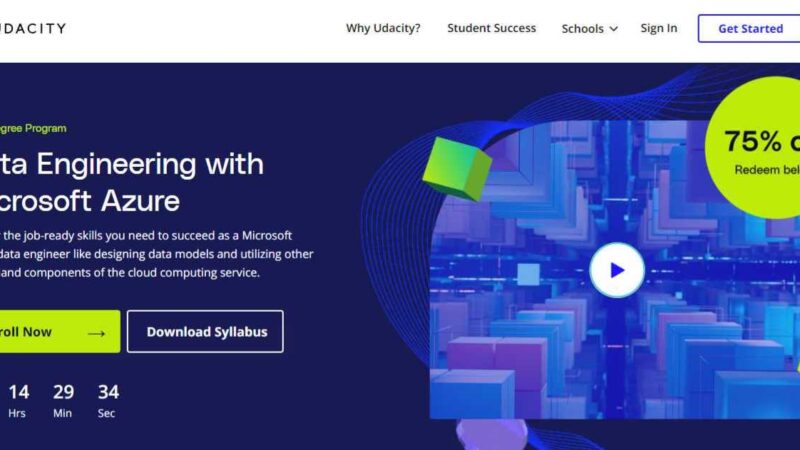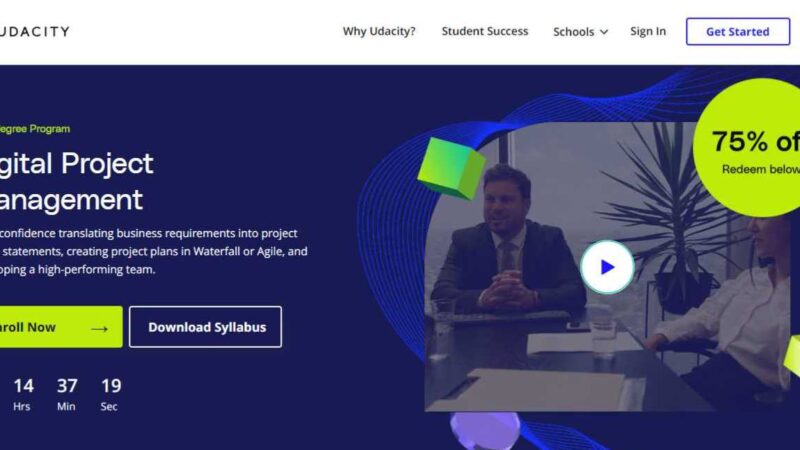Udacity AI for Healthcare Nanodegree Review

AI is a hot career. It can enhance any field, including retail, food, and even healthcare. As we advance in technology and medical devices, we are making groundbreaking discoveries and producing a new generation of digital healthcare that is increasing our ability to save lives. Combining the power of AI with the ever-evolving world of medical devices is a huge advantage, one that is in high demand.
Those with knowledge of Python and machine learning can set their sites on a career in AI for healthcare, starting with the AI for Healthcare Nanodegree from Udacity. This course provides a look into medical devices and wearables, taking learners on a journey as they attempt to develop the best software to enhance them. Through video lectures and hands-on projects, learners will work in all areas of the field, just like a real developer would.
A Bit About Udacity
If you’ve never heard of Udacity, we’re glad you’re here! They have teamed up with several top names in the industry to create in-depth courses that tackle real-industry issues. You will find all kinds of topics and video lessons for free and courses you can take for a fee. Included in these courses are nanodegrees, which come with a certification and other perks that set them apart from other online courses out there.
What’s a Nanodegree?
A nanodegree from Udacity is a short course meant to take learners in-depth on a particular topic. These are short and usually take just a few months to complete. At the end of each nanodegree, learners receive a certificate plus, can say they learned from one of the best online academies out there today. Included with each nanodegree are a few extras, most of which are worth bragging about. The extras are:
- A personal tech mentor- just in case!
- A community of learners to keep motivated
- Career prep and advice including mock interviews with feedback
- Real industry projects that mimic issues and challenges of today
- A-list instructors with both teaching and industry experience
Meet your Instructors
Nikhil Bikhchandani
Nikhil has worked with wearable devices employed by both Google and Verily Life Sciences. During his five years, he has worked with technology to create devices for cardiovascular and neurodegenerative diseases as well as diabetes. He has an impressive education and a killer resume-both of which shine in his lessons. He is passionate about healthcare and the enhancement technologies can bring to the field.
Emily Lindemer
Emily is an expert in AI. During her time in the industry, she has worked with medical imaging technologies and founded her own digital health company. She teaches through examples plus, provides a glimpse into the business side of technology in the healthcare world.
Mazen Zawaideh
Mazen is currently working with Neuroradiology at the University of Washington. He is working with others to develop minimally invasive therapeutics that will take healthcare to the next level. His deep understanding of the neural system along with experience working in the field serves as amazing examples that he uses during his lectures.
Course Breakdown
Prerequisites
This course focuses heavily on intermediate and advanced techniques used in machine learning. For this, those wanting to take the course should have a solid grasp on the Python programming language, able to read and understand code and make use of the NumPy library. Perspective learners should also have worked with machine learning, understanding supervised learning. Application of Python to machine learning is a must, including the manipulation of clean data.
Lesson One: Apply AI to 2D Medical Imaging
You will get right to work on learning how to use technology to enhance medical images. Working with 2D x-rays, mammography, and digital pathologies, you’ll use AI to derive these images and improve images for better analysis. You’ll build AI models depending on the scenarios given and learn about regulatory approvals before starting on your first project.
Project! Pneumonia Detection in Chest X-Rays
In this project, you’ll train a CNN to classify pneumonia. Working to automate systems to extract images from DICOM files, you’ll use AI to enhance them. The final piece of this project is creating and writing a FDA501(k) which describes the model you created and shows that it meets FDA standards for use in the medical field.
Lesson Two: AI with 3D Imaging
Those that analyze x-rays often see images in 3D, relying heavily on AI. In this section, you’ll see the process from start to finish, understanding how images are obtained, saved, and analyzed at a later time. After you have a grasp on the process, you’ll apply machine learning algorithms to solve challenges in 3D imaging.
Project! Hippocampus Volume for Alzheimer’s Progression
One challenge that the industry is facing today is the detection of Alzheimer’s progression. It takes a 3D image and lots of time to measure volume that could be optimized using the help of AI. This project allows you to try and tackle this challenge, creating algorithms that will help locate the hippocampal volume and save technicians and patients time.
Lesson Three: AI for EHR
EHR data is important for hospitals. In this section, you’ll learn about EHR data and how to keep it safe and secure. One of the largest challenges in the industry is the analysis of this data, as it comes packed in large and merely unreadable data sets. Learning how to organize data, you could use it to find patients for clinical trials for studies to enhance medical care.
Project! Select Patients for Diabetes Drug Testing
In this project, your goal is to predict the estimated hospitalization time for patients. You will act as a data scientist for a company that is on the verge of releasing a groundbreaking diabetes drug that needs clinical testing.
Lesson Four: AI for Wearable Devices
Wearable devices are an advancement in the healthcare field. They collect data about the health of the patient wearing them, immediately processed and analyzed. This is thanks to the analysis made possible through algorithms that automatically collect, store, and analyze data for future use. Use your knowledge learned in this section to power through the final project.
Project! Motion Compensated Pulse Rate Estimation
You are now ready to act as a data scientist. You’ll work with sensors and use the help of algorithms to collect the wearer’s pulse by connecting datasets collected by two sensors. This is something that data scientists in the medical field must do to optimize collected data. In this way, you will have enhanced a wearable device, using the help of technology and complex algorithms to automatically complete the task.
How Long Does This Course Take?
Udacity estimates that, at 15 hours per week, learners can finish the course in 4 months. This means getting through the content and completing the projects before the given due date. Learners can choose to learn at their own pace, but might not want to take too long. That is because Udacity charges based off of the amount of time the course takes to complete. More on that below.
What’s the Course Cost?
The total cost of the course depends on the amount of time you take. Udacity has two ways to pay, both of which are great options. The best deal for you depends on the amount of time you have to dedicate to the course and your budget.
If you wish to pay as you go, you can take all the time you want as long as you meet the project deadlines. Sounds easy enough, and it is, but it comes with a cost. Each month of access comes with a price tag of $359, which can add up fast. Take Udacity’s suggested 4 months and you’re looking at close to $1500. While it is not bad, you might be able to save some dough taking the other option.
Udacity estimates the time it will take to complete the course to offer a deal. If you take this option to pay, you’ll get 4 months of access plus, a 15% discount bringing the total to $1236. This is a pretty good bargain, especially if you think you’ll take the full 4 months to complete the course.
What Learner’s Say
“Overall, the program is extremely unique and helpful. I strongly recommend this course for those who are interested in Machine Learning/Deep Learning and want to know how to apply their technical skills into one of the most critical field of human life – healthcare. The content of the course is carefully designed so that you can gain a deep insight of the field.” – Nguyen V.
“The program is going well and it matched my needs and expectations. Initially I was not confident that I will complete the project and I felt that they are too hard and beyond my abilities , but I never gave up , I made notes for each and every video in the chapter, I analysed and interpreted code. I took time for understanding every piece of project and finally made it !. I am thankful to my mentors and reviewers for their support throughout this chapter.” – Ritish M.
“It’s been great. I would have loved a more done to get the app into the hospital system. How to convert the inference file into a living running app inside the client. I presume the inference behaves like an edge computing with API to the model for computing in the cloud. Also, I would have loved a little bit on how to protect and secure your code from being stolen by hospital staff” – Kofi O.
How’s the Job Market?
AI is a sensitive topic for some. It creates jobs for developers, programmers, and those with development knowledge but, takes jobs away from others. While AI enhances many things, it is preferred in some areas over its human counterpart. That is because they do things faster, more efficient, and without the risk of human error. Not to burst your bubble, this is good news for you! However, the push for AI is not all that easy as a large number of technicians and clinicians would be left jobless.
On the positive side, AI is a hot commodity. Those with the skills to develop complex machinery and with experience with machine learning and Python have a huge advantage, perhaps entering a career field that hasn’t quite taken off yet. Getting hired by a company is easy nowadays, as there are lots of jobs up for grabs plus, the salaries are generally not under 6 figures.
Final Thoughts
AI is taking industries to all new heights. It takes the use of machines and complex algorithms to create devices that will power tomorrow’s technology. Combining the power of AI with the knowledge of programming with Python and machine learning techniques, industries like healthcare are bound to see a whole new light. While it sounds like a difficult path, learning the skills needed to land a career as an AI tech for the healthcare industry are not that hard to come by. With the Udacity AI for Healthcare Nanodegree, you’ll get a good look into the industry, understanding the challenges that technicians and developers face.
Noticing these problems, you can work to create solutions that could possibly put an end to these problems, changing healthcare forever. Taking the course with a reputable academy like Udacity, you’ll be on the right path to possibly landing the career of your dreams. Be sure to think about the time you have to dedicate to the course, as it will help you choose the way to pay. Keep deadlines in mind, so you don’t waste any time on completing the course and starting your path toward a career in AI. Starting today, you can be done and starting your way into the field in as little as 4 months. Our only question is, what are you waiting for?
